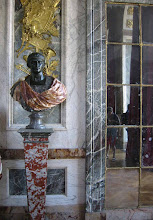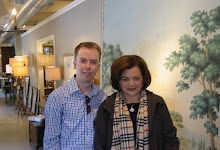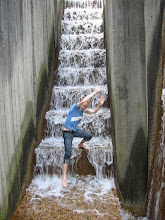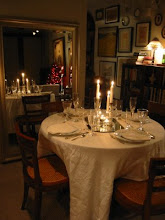Under heavy renovation and possibly finished by 2016, The Neues Palais (or new palace) in Potsdam is one of the more impressive structures in the area. Parts of Potsdam are basically a suburb of immense palaces, now nearly all museums. There are many excellent books available on the many palaces and the area itself.
The Neues Palais wasn't meant as a home for the King when it was completed in 1769 but rather as official state apartments for entertaining other royals and ambassadors. Therefore it was built to impress and not necessarily be very homey for the monarch who retained a small apartment in the palace.
Opposite the palace (above) are the Communs (seen below), creating an entry courtyard. The Communs held the kitchens, service spaces, and offices for the palace - a sort of 'downstairs' if you will. The king had underground passages built connect the Palais to the Communs so servants could get between the buildings unseen but also undeterred by weather.
The ornate interiors are astounding. Designed in the Baroque style favored by the king they're beginning to show traces of upcoming Neoclassicism. Frederick the Great didn't like the strict lines of Neoclassicism so you have to look hard though!
The palace was originally designed by Johann Gottfried Buring. Buring had completed other buildings in Potsdam for the king but was fired from the job after it was started after disagreements on the palace facade. Perhaps Buring wanted to bring in the 'new' Neoclassicm.
I don't know, I think some of the rooms look pretty Neoclassical to me, wouldn't you agree? They could have been remodeled at a later date.
The floors in the palace are stunning. The parquet floor above looks absolutely modern to my eyes.
Carl von Gontard took over construction of the palace after Buring's dismissal.
The salon above is really interesting -I love how the treatment continues to the ceiling.
Almost a sort of garden room. Also notice the modern light fixtures which are hung holding all of the modern necessities like security.
While these modern fixtures might seem strange to some, I like that they don't damage any of the delicate walls and finishes and stand separate and discreet as their own 'thing'. Europeans do this exceptionally well.
More gorgeous parquet floors, almost like fine furniture.
After awhile all of these grand rooms start to look the same; gold, gold, and more gold.
I think we need to bring back the use of bed niches.
I imagine particularly in the 18th century Germany the alcoves felt really cozy and warm before central heating.
More gorgeous painted paneling - chinoiserie here. No gold here!
The palace was later used by successive monarchs as a full time residence and it was therefore renovated with modern conveniences. I love the Victorian heat grate above.
But not all of the rooms are gold. A number of rooms are silver gilded like the bedroom below. I suppose the silver would reflect candlelight just as well if not better than the gold gilding.
As always thanks so much to my Australian penpal Neil for supplying us with these gorgeous images from his travels. If you find yourself in Berlin a visit out to Potsdam is really heavily encouraged: read more about visiting Potsdam palaces here.
Friday, November 14, 2014
Neues Palais, Potsdam
Labels:
architecture,
Germany,
history,
inspiration,
Interiors,
Neues Palais,
palaces,
penpal,
Potsdam,
travel
Tuesday, November 11, 2014
Visiting Dumbarton Oaks, Georgetown
This past weekend offered beautiful fall weather, perfect for our Mid-Atlantic ICAA tour of Dumbarton Oaks arranged by landscape architect and boardmember Jennifer Horn.
Dumbarton Oaks has been owned by Harvard University since the early 1940s and hosts a number of their graduate programs on campus. Sections of the famous gardens are open to the public and their renowned museum has a separate entrance on 32nd street NW.
Although much changed and constantly evolving, the gardens are the the work of famous landscape designer Beatrix Farrand, seen in the portrait above.
Unfortunately the house is undergoing some renovation work (roof and some structure being replaced) so scaffolding covered the neo-Georgian facade. You can see photos of the house at my earlier post from 2009 HERE.
The library is housed in the wing seen above designed by Thomas Waterman -a really spectacular period room in which one can study the antique landscape books in an elegant setting.
This grotto is only one of the many charming spots to be found throughout the gardens. The modern balustrade is very plain-jane compared to others found throughout the property but I suppose it meets code (most ugly railings do).
One of the best parts of attending the ICAA tours (everyone is welcome btw!) is that you get an opportunity to see many behind the scenes areas not open to the general public.
I had never seen most of the campus before and was thrilled with many of the original structures like the green house above, where plants are still grown for the gardens. The brick structure in the center was originally designed to be the library until someone came to their senses and realized antique books and water don't mix!
Washington is enjoying a spectacular fall this year which doesn't often happen. So often I feel we move directly from summer into winter.
Many of the older structures such as the garage above have been wonderfully preserved on the exterior while the interiors have been unfortunately gutted and rebuilt in an institutional manner. Don't even ask about some of the modern buildings I'm not showing here and other work done on campus by architectural firm Robert Venturi - the less said there the better ( # inappropriate, # generic, # ugly ).
Many of us architects marveled at the lovely back door above - nicer than the front doors on many houses! Also notice the intricate brick paving patterns designed by Farrand.
The use of ornate brick and stone walls throughout the hilly, terraced gardens is one of my favorite aspects.
While these are special details, they are to be found throughout the entire property.
Above is one of the many railing designs by Farrand - this may not meet modern day codes but is none-the-less pleasing to the eye.
Even the simple wooden garden bench above has lovely details; notice the scrolled bracket to the sides.
Inside the museum there are more wonderful treasures to check out. I particularly like the antique byzantine mosaics which are built into the flooring. The rather strange addition by Phillip Johnson, celebrating its 50th birthday, is growing on me and is a great example of marrying a modern addition to a classical structure (Robert Venturi take note!). Please join the ICAA on our next adventures and be sure to check out Dumbarton Oaks while in Washington, you won't be disappointed!
Dumbarton Oaks has been owned by Harvard University since the early 1940s and hosts a number of their graduate programs on campus. Sections of the famous gardens are open to the public and their renowned museum has a separate entrance on 32nd street NW.
Although much changed and constantly evolving, the gardens are the the work of famous landscape designer Beatrix Farrand, seen in the portrait above.
Unfortunately the house is undergoing some renovation work (roof and some structure being replaced) so scaffolding covered the neo-Georgian facade. You can see photos of the house at my earlier post from 2009 HERE.
The library is housed in the wing seen above designed by Thomas Waterman -a really spectacular period room in which one can study the antique landscape books in an elegant setting.
This grotto is only one of the many charming spots to be found throughout the gardens. The modern balustrade is very plain-jane compared to others found throughout the property but I suppose it meets code (most ugly railings do).
One of the best parts of attending the ICAA tours (everyone is welcome btw!) is that you get an opportunity to see many behind the scenes areas not open to the general public.
I had never seen most of the campus before and was thrilled with many of the original structures like the green house above, where plants are still grown for the gardens. The brick structure in the center was originally designed to be the library until someone came to their senses and realized antique books and water don't mix!
Washington is enjoying a spectacular fall this year which doesn't often happen. So often I feel we move directly from summer into winter.
Many of the older structures such as the garage above have been wonderfully preserved on the exterior while the interiors have been unfortunately gutted and rebuilt in an institutional manner. Don't even ask about some of the modern buildings I'm not showing here and other work done on campus by architectural firm Robert Venturi - the less said there the better ( # inappropriate, # generic, # ugly ).
Many of us architects marveled at the lovely back door above - nicer than the front doors on many houses! Also notice the intricate brick paving patterns designed by Farrand.
The use of ornate brick and stone walls throughout the hilly, terraced gardens is one of my favorite aspects.
While these are special details, they are to be found throughout the entire property.
Above is one of the many railing designs by Farrand - this may not meet modern day codes but is none-the-less pleasing to the eye.
Even the simple wooden garden bench above has lovely details; notice the scrolled bracket to the sides.
Inside the museum there are more wonderful treasures to check out. I particularly like the antique byzantine mosaics which are built into the flooring. The rather strange addition by Phillip Johnson, celebrating its 50th birthday, is growing on me and is a great example of marrying a modern addition to a classical structure (Robert Venturi take note!). Please join the ICAA on our next adventures and be sure to check out Dumbarton Oaks while in Washington, you won't be disappointed!
Labels:
Architect,
Beatrix Farrand,
DC,
designer,
Dumbarton Oaks,
Gardens,
house tours,
ICAA,
Mid-Atlantic ICAA,
opportunities,
tours,
Washington
Subscribe to:
Comments (Atom)













































































.JPG)







































































